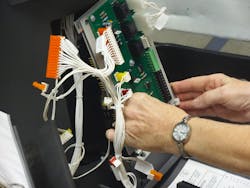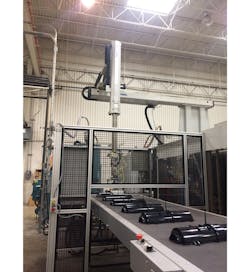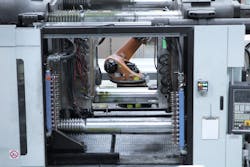The Design Engineer’s Checklist for Injection Molding
Download this article as a .PDF
Injection molding is a highly-engineered process that demands careful planning and attention to detail if the finished product is to achieve its full potential. The tips in this article should help designers and engineers understand some of the basics about injection molding, so that they and the injection molder can work together to make the best possible decisions during the part design and development process.
Where to Begin?
The first step in designing any injection molded part is answering some basic questions:
- What function(s) will the part serve?
- What market(s) will it serve? (automotive, industrial, medical, housewares, food containers, etc.)
- What kind of design project is it? (A new part or product? A part redesign?)
- Who are the “stakeholders” in this part design project? Included in this group are all suppliers in the chain of production, original equipment manufacturers (OEMs), the sales and marketing teams, and other companies that add value to the part. Each link in this stakeholder chain will often have its own set of requirements for the part’s design. If you can identify these early, you will save time, money, and rework later.
Design and Supplier Considerations
Here is where you establish the design goals and priorities. The design of any part starts with balancing the multiple goals associated with it, and establishing which of these goals have the highest priority.
For all parts, safety will be a vital consideration, but you’ll also want to know the following:
Is the objective to reduce manufacturing costs by combining what were formerly multiple parts into a single one to eliminate assembly work? Or is it to reduce part weight, improve functionality, simplify the product’s design, increase strength/rigidity, or all of the above? Are aesthetic considerations (color, texture, configuration, etc.) critical? Or is part strength more important?
Some other questions to consider in this stage include:
Who will own the final part design and the tooling? Many customers come to us with an existing design—often one developed by a previous injection molding company, their own in-house part designer, or a part created by a contracted designer. At the completion of the project, however, the customer should always own the part design and the associated tooling.
Does the molding supplier you’re considering have experience in your industry? For instance, automotive, medical, and household product designs are subject to differing requirements and specifications.
What are your project’s deadlines and milestones? Don’t delay getting your molding supplier involved in the process, even in the concept stage. Early design decisions are where the most opportunities for cost savings can be identified. Resins will change based on desired materials properties. For example, impact resistance might change the additives or resins used in an application. Knowing the resin up front will impact how the mold is made and thus prevent design changes and rework later.
Choosing the Right Injection Molding Process
With a few exceptions, an experienced contract injection molder can accommodate almost any thermoplastic resin and nearly any design the OEM may choose. For example, some resins run at very high temperatures, requiring a specific kind of equipment. “Micro-molding” of very small parts and single-piece fabrication of large parts also may present a challenge for some.
For the most part, the following molding technologies will suit the requirements of a wide range of applications.
Traditional injection molding. Typically done in two stages, melted thermoplastic is first injected into a mold. Heat and pressure is applied filling the shape of the mold cavity. Upon cooling the part solidifies, and is then ejected from the mold. Most injection molding presses can produce parts weighing anywhere from a few grams to 17 lb.
Structural foam injection molding. Structural foam-molded plastics can replace many types of materials, including metal, wood, concrete, and fiberglass, resulting in a part that weighs 10 to 30% lighter than other parts, but is just as durable.
Gas-assisted injection molding. This molding process involves injecting an inert gas into an injection-molded part during the packing stage, providing dimensional stability for thick molded parts and reducing warp and sink marks. This technique can also reduce clamp tonnage requirements, saving energy and cost.
Overmolding. This is the process of combining two or more molded plastic, metal, or elastomer parts to make a single finished part.
Preliminary Design Specifications
To aid all parties in developing or refining a part design, here are some of the key project requirements that should be part of the initial discussions.
Part Geometry
Some part geometries can be difficult to injection mold. Part size, shape, and wall thickness can make the part prone to warpage, bow, and other defects. Features like snaps, undercuts, bosses, ribs, and windows can complicate the molding process and increase costs.
To get ahead of potential part defects, some large OEMs have internal capability to use their CAD renderings and sophisticated software to run simulations on the design before it’s even an approved project. It’s very important to run these analyses, no matter who is performing them.
Material Selection
The first step in the resin selection process is to identify the key physical attributes that your end product requires, such as strength, electrical properties, resistance to chemicals, impact, or temperature.
Thermoplastic resins come in two basic classes: engineering grade resins and commodity resins. Here’s a rundown of resins in both classes, and some of their key characteristics.
Engineering Grades
- Nylon – tough, superior thermal and chemical resistance
- Polycarbonate – strong, good temperature range, transparent
- ABS – good impact strength, surface quality, colorability, and rigidity
- PC/ABS – good processability, toughness at low temperature, superior dimensional stability
- Thermoplastic elastomers (TPE) – “soft” touch rubber replacement materials, good tear strength and flexibility
- Acrylic – transparent, good for some outdoor applications
- Acetyl – excellent wear resistance, great for gears
- Structural foam – good weight-to-stiffness ratio, excellent metal replacement
Commodities Grades
- Polypropylene (PP) – good fatigue resistance, excellent chemical resistance, lower cost
- Polyethylene (PE) – versatile, low-cost, tough, weatherable, easily processed
- Polystyrene (PS) – lower cost, wide range of impact, good clarity and rigidity
- Polyvinyl chloride (PVC) – low cost, chemical resistant, can be colored, weatherable, naturally flame retardant
Strength Requirements
Describe the level of strength the part requires. Some parts must be able to withstand repeated impact or force (such as a switch), while others need to support the weight of internal components.
If it’s a load-bearing part, describe the amount of weight or stress it must withstand, the duration for which the load will be applied, the size of the bearing area, specifications for tensile strength (the greatest longitudinal stress a substance can bear without tearing apart), and any required safety factor.
Required Impact Resistance
The questions to ask here center around the type of expected impact load (e.g., a fall onto a hard surface from 5 ft. or having loads dropped on it). Impact testing offers valuable insights. By using molds that are similar to the final part, the molding partner can produce prototype parts using an array of resins, and then compare their impact resistance.
Temperature Exposure
Considerations around temperature exposure include:
- Minimum/maximum temperatures the part must withstand
- Type of heat source (flame, sun exposure, heating element, etc.)
- Heat deflection temperature (HDT), or the temperature at which a polymer or plastic sample deforms under a specified load
Use Environment
Whether the part is to be used indoors or outdoors, it’s important to identify any factors that may have an impact on part appearance or performance, such as bacteria, flame, or chemical and moisture resistance.
Color
Even among all of the technical requirements for your injection molded part, the part’s appearance and aesthetics are also key considerations. The designer, engineer, and injection molding partner will need to discuss and understand things like:
- Color palette requirements (Does it need to match a corporate branding identity standard?)
- Color consistency
- Part-to-part color consistency
- Color stability during molding
- Color stability (initial and long-term)
- Depth of color
Safety and Regulatory Compliance
If a part or product fails, liability for personal injury, property damage or environmental impact may be incurred. While legal advice is outside the scope of this article, liability concerns drive nearly every aspect of equipment production, especially for medical devices and medical equipment products.
Depending on the part’s use, it may need to be tested and certified by various governmental and/or private, national and international agencies like the American Society for Testing and Materials (ASTM), the Food and Drug Administration (FDA), the Environmental Protection Agency (EPA), the American Nation Standards Institute (ANSI), and the Occupational Safety and Health Administration (OSHA).
Cost
What is the optimal cost-per-part that will ensure profitability for the project? The answer to this question is satisfied by the OEM. Their concerns can include:
- Break even, run quantity, and duration
- Production planning: Does the volume of production justify the cost of having more than one tool created at the same time?
- Optimization: Shipping, secondary operations, and efficiencies
Product Lifecycle
Will the device experience continuous use, or will it see only periodic use? It matters if an injection molded part is under stress once a day or once an hour. It also matters how much abuse or wear and tear the product might encounter during its life. For example, if it’s on a stand, must it have an impact rating for accidental tip-over?
Estimated annual usage, production quantities, and the expected lifespan of the product will influence many decisions about the part, including mold design, material choice, and finishing methods.
Have a Checklist Handy
These are some of the many questions and considerations that all parties in an injection molded part project must understand and agree upon before starting a job.
It may sound a bit redundant and tedious, but at Ferriot we even recommend developing a checklist—on paper, even—with all of the questions and requirements that the designer or engineer and injection molding contractor should understand and agree upon before getting started. Some questions that should be on your checklist include:
- What is the desired part(s) and its description?
- What is the size and shape of the part?
- Who and what is the part for?
- How will it look? What are the aesthetic and brand identity considerations?
- What are the strength and rigidity requirements of the part?
- What, if any, fastening/assembly methods are to be used?
- What is the optimal cost per part?
- How many parts do I need?
- What is the expected lifespan of the part?
These tips provide the design engineer with a significant head start on his or her injection molded part project. The selected injection molding partner, potential end-users of the part, and all of the project stakeholders will appreciate all the careful decision-making and heavy lifting up front that makes the injection molding project run smoothly, resulting in a part that’s delivered on time and on budget.
Dave Perkowski and Dave Swigeart are Senior Tooling Engineers with Ferriot Inc., a full-service contract manufacturer and molder of engineered resins based in Akron, Ohio.




